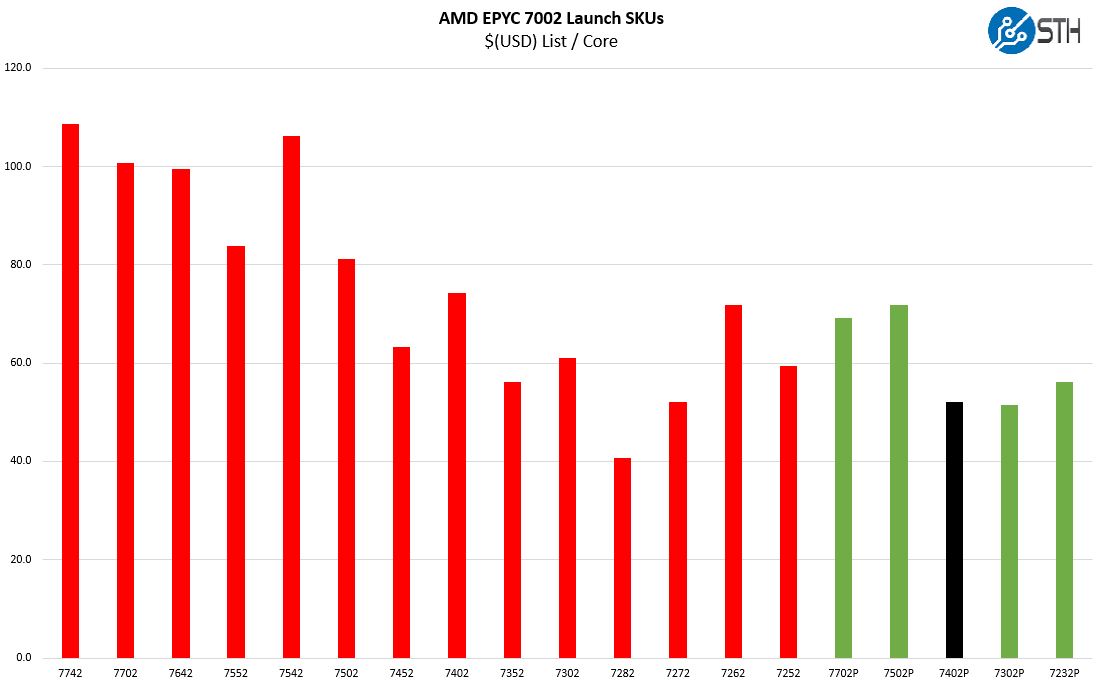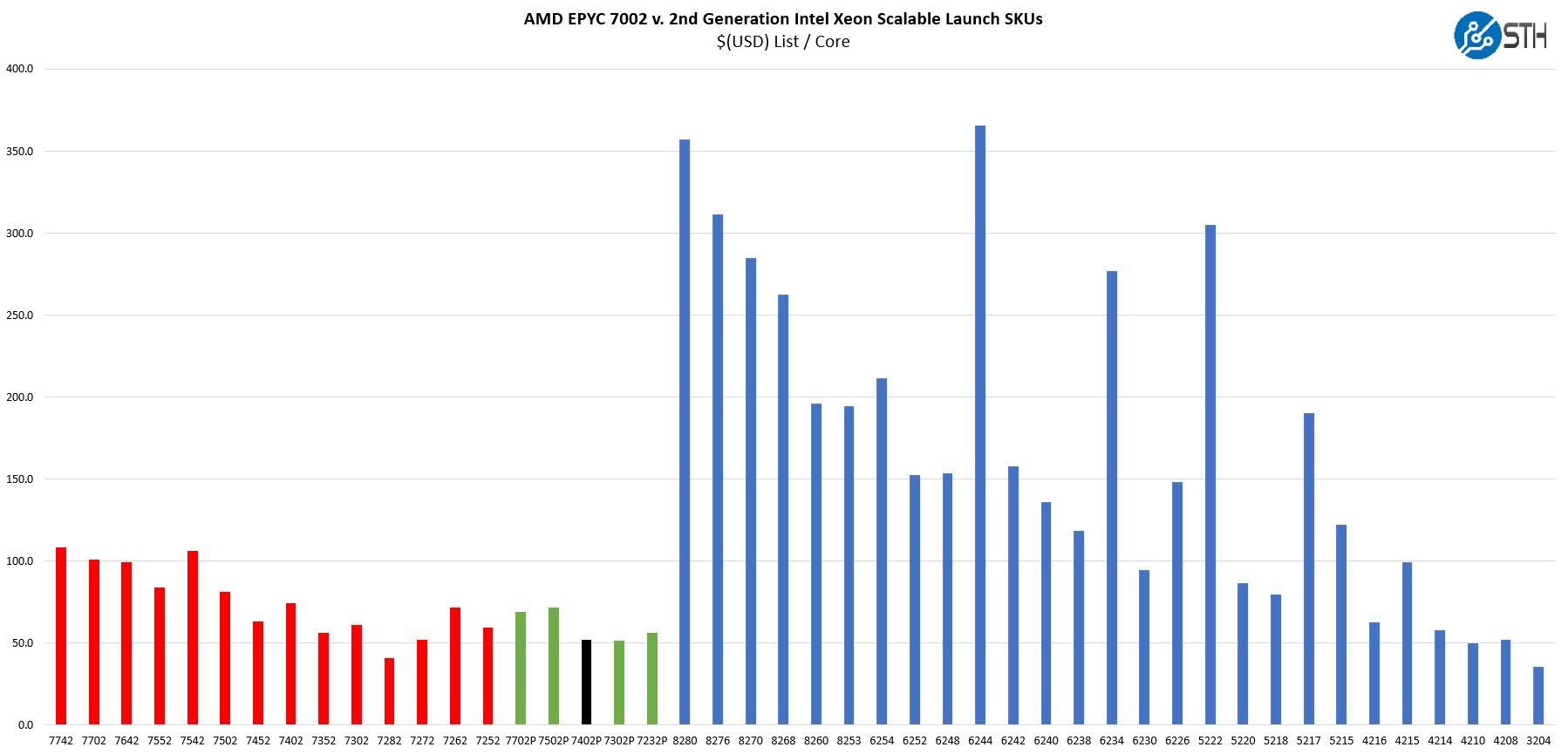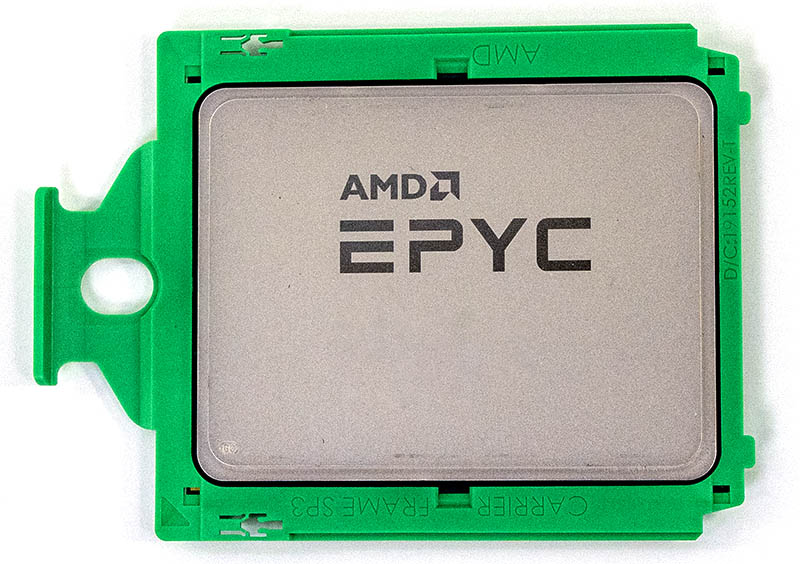AMD EPYC 7402P Market Positioning
Thes chips are not released in a vacuum instead, they have competition on both the Intel and AMD sides. When you purchase a server and select a CPU, it is important to see the value of a platform versus its competitors.
AMD EPYC 7402P v. AMD Alternatives
AMD did not make it easy to pick a CPU with this generation. Take a low-end AMD EPYC server complete with an AMD EPYC 7402P, 256GB of DDR4-3200, 25GbE, and boot drives and you are generally in the $6000 range.
If you push your budget to around $7200, you can swap in an AMD EPYC 7502P with 33% more cores for about 20% more cost. On more fully configured servers, the price delta goes down from there. It can be hard not to take that additional 8 cores for more performance per dollar.

At the same time, one can spec down to a single AMD EPYC 7302P CPU with performance similar to two Intel Xeon Silver CPUs and save another $425 that can be deployed elsewhere.
The wildcard is that AMD can easily handle more RAM and more cores in a single socket. 24 cores are less than half of what one can put in the socket with a 64-core AMD EPYC 7702P. If your TCO model is built on more compute at lower power and lower cost per core, then the EPYC 7702P is the right answer. The real cost there is lower clock speeds, but one can easily make a case for this.
AMD EPYC 7402P v. Intel Xeon Alternatives
This is very hard. The AMD EPYC 7402P series brings performance per core rivaling modern Intel Xeon Scalable Gold and Platinum CPUs. From a price perspective, AMD is pricing the EPYC 7402P closer to the $/core of the Intel Xeon Silver 4200 line.
We added the Intel Xeon Scalable mainstream (non-airline booking ticketing fare SKUs e.g. T, V, Y, N, M, L) for some context.

The AMD EPYC 7402P performance is competing at the segment to the far left of the blue bars for Intel Xeon Platinum 8200 and Gold 6200 SKUs, but is priced on a per-core basis more like low-end Xeon Silver SKUs.
What is more, the AMD EPYC 7402P has more PCIe lanes than two Intel Xeon Platinum 8200 or 9200 CPUs. It also utilizes PCIe Gen4 so each lane is effectively twice as fast. If you need a lot of I/O, then you are looking at using two of Intel’s midrange CPUs to equal the small black bar shown for the EPYC 7402P.
Once we started to get our internal test data back, and we learned pricing, it became harder to buy Intel Xeon. Some of the key areas we are buying Intel Xeon for is around Intel Optane DC Persistent memory, something that AMD currently cannot match.
Intel will be competitive as it finally gets to 10nm in 2020. At that point, AMD will be readying its next-generation EPYC 7003 parts. Still, as of when we wrote this review, this is a very one-sided picture.
Final Words
With the AMD EPYC 7402P launched, we actually think it may represent the best value processor on the market. That is because of balance. Looking at pure cost per core, it is relatively inexpensive, but it is not the lowest ratio in AMD’s stable. What it does have is a sweet spot of enough processing power, memory, and I/O to potentially retire 1.5 to 2 dual Intel Xeon E5-2630 V4 era servers. If you are paying for VMware per-socket licensing, moving 3:1 or 4:1 may entirely justify the business case of moving to EPYC. If you are a Linux shop using open source software the AMD P-series pricing is excellent compared to other CPUs on the market.

Core for core, there are still a few areas that Intel Xeon Scalable processors excel. For example, if you are a developer that wants VNNI, your are a HPC customer that demands AVX-512, or if you need Intel Optane DC Persistent memory. If you specifically try to bypass the massive cache usage, Intel performance can look good. Still, for most of today’s workloads, AMD has a distinct advantage due to its more modern architecture. Intel is heading this way, but its competitive products are not yet in the market.
The biggest question on the AMD EPYC 7402P is competition from the AMD EPYC 7302P and EPYC 7502P with eight fewer and more cores respectively. Our reviews of those are already written and in the queue to help you decide further, but we wanted to start in the middle of the SKU stack to put a guidepost out there for our readers. In the EPYC 7001 generation, we purchased many EPYC 7401P systems after our testing. In this generation, the EPYC 7402P will likely be our CPU of choice as well.




Thanks for the review, always appreciated!
Could you show the result of lstopo? Preferably with all pcie slots populated.
Also it would be very interesting to run the cuda P2P benchmark populated with Nvidia GPU’s.
Very interesting review, thanks for putting in the solid effort and detail. The new EPYC 7002 CPUs are certainly the best choice in most situations.
How will the 24 core EPYC 7402p chip work with virtualization of of 4 core and 8 core VMs? Will the CCX layout put this particular CPU at a disadvantage?
What’s that writing on the green part in black pen?
Great write up! Thank you for including your results for SPECrate2017_int_base. Would it be possible to include the floating point “rate” and “speed” varieties too next time around too?
Stellar review STH
Thanks for the review. is the clock speed high enough on the 7401P to use in a workstation?
Patrick, wondering if you’ve tried the 7402 in a Dell poweredge 7415 server to see if it will work.
A lot there.
k8s – we can see. Perhaps in the forums when it gets open. I think we had one or will have one in a review coming up.
Esben – It worked well enough that in our KVM testing we did not see any issues. VMware/ Hyper-V may be different of course. New architectures tend to get patches over time.
HankW – We have a lot of CPUs. Marking the model number on the carrier helps tell if a CPU’s thermal paste is not cleaned. It is a lab hack.
David – we can look into that. Another option is to just look at official vendor runs on the spec.org site. Vendors have teams that focus on optimizations.
Martin – I have thought about it. It is likely usable, but I would still suggest using a desktop chip if possible. The 4.0-5.0GHz speeds are nice on modern desktop CPUs.
Steve – not yet. Dell said they will announce Rome systems soon. Stay tuned.
@Martin: The most recent ThreadRipper leak suggests that AMD will introduce a workstation tier in the TR line. If true, yo can rasonably call it a desktop Epyc – 8 RAM channels + (L)R-DIMM support, 96-128 PCIe lanes, and most probably higher frequencies.
Nice review! Do we know the relative performance pr CORE@same freqyency on Intel Gold 6140 (1gen cascade), Intel Gold 6240 vs Epyc 7×02 ? In other words core IPC performance vs. the competition?
/TE
Expect to see something from Dell next week.
Great review – thanks!
Any plans to compare 7402P performance with dual 7272 (2×12 cores; 2x $625) and/or dual 7282 (2×16 cores; 2x $650) which cost almost exactly the same but have twice RAM bandwidth and 2x higher RAM size limit?
Also, any plans to benchmark dual 7452 which seems to be as fast or faster than dual Xeon 8280 in many (most?) cases of server workloads?
@ Esben Møller Barnkob
In my data center I have a couple Dell R7425’s with dual 7401 CPUs and there is no problems with virtualization of 4 or 8 core VMs, including running DB’s on it.
I can’t make sense of most of the graphs. Not in terms of “oh, this processor is faster/slower”, but in terms of the colour choices.
In the first chart, Linux Kernel Compile Benchmarks, green bars are AMD processors, blue bars are Intel processors and the black bar is the 7402P (the reviewed processor).
In C Ray 8K Benchmark, however, the green bars are still AMD processors, and the black bar is still the 7402P, but the blue bars are a mix of Intel and AMD processors (7551P, 7401P, 7351P, 7251).
In NAMD Benchmark, the blue bars are Intel plus 7401P, 7371, 7351P, which is different from the mix in C Ray 8K.
OpenSSL Sign and Verify Benchmarks, blue is Intel plus 7401P, 7371, 7351P, as in the NAMD benchmark.
GROMACS STH Small Case Not Zen2 Optimized Benchmark … Black is now Intel, Green is still AMD (but now has the tested 7402P and blue is Dual 7601, 7601, 7551P, 7401P
Chess Benchmark, blue is Intel plus 7401P, 7371, 7351P
SPECrate2017_int_base Benchmark, blue is now the tested 7402P, and black is Intel.
In an otherwise excellent article, the lack of consistency in the colours chosen for the graphs is really detracting, as it makes it difficult (for me at least) to skim the graphs and still get a decent idea of what they’re showing, because it forces me to constantly check the labels for each bar.
7402P is a great CPU, and what makes it even better is power consumption: under sustained heavy loads the 1014 platform hovers at just above 200W, making it easy to fill a standard 40U 8kW rack without worrying about going over the limit while keeping every server configuration identical. Unfortunately, Supermicro ships the platform with ridiculously overpowered dual 500W power supplies, operating in sub-optimal power range when redundant with no add-in cards.
Comparable platforms with Intel’s 62{09,10,12}U installed, in my experience, perform slightly better in single-threaded tasks, but their peak power consumption is significantly higher than in platforms with Rome, even
I’m looking forward to see my fleet upgraded with the new AMD systems. Coincidentally, I’ll be upgrading dual 2630v3/4s, just like this article suggests; I figured a safe bet would be about 1.5x old servers per new one, but time will tell if I was right.